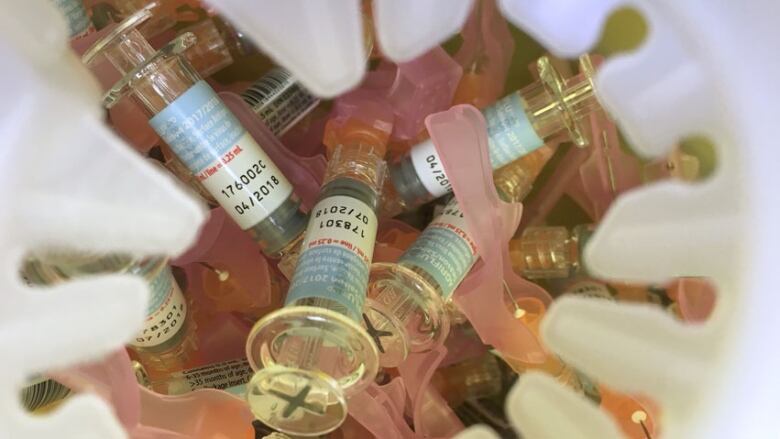Flu-related deaths in Manitoba spike to 17 this season
Fatalities have nearly doubled in past week

The number of flu-related deaths in Manitoba has nearly doubled in the past week, nowsurpassing last year's total.
From September to last week, there were nineflu-related deaths; that number has climbed to 17, according torecent data tracked by the surveillance branch of the province's public health division.
By comparison, at this time last yearthere was only one flu-related death and none in the 2015-16 flu season. In total last year, there were 12 flu-related deaths.
Officials say this flu season, which is dominated by the H3N2 virus, is similar in severity to 2014-15. At this point in the 2014-15 flu season, there were 16 flu-related deaths.
"It's a normal influenza virus. In the Southern Hemisphere for some reason or other it seemed to be very aggressive and we saw a lot more deaths, but in Manitoba for sure we're not seeing we're having a whole lot more people dying," said Dr. Richard Rusk, medical officer of health for communicable diseases.
In total since September, there have been 113 hospital admissions related to the flu, with65 per centof the afflicted aged 65 or older.
By comparison, in the 2014-15 flu seasonthe total number of flu-related hospitalizations was 350, 65 of whom were admitted to intensive care.
A total of 48 influenza associated deaths were also reported that year. The majority of the hospitalizations and deaths were associated with influenza A, according to the annual report for 2014-15.
"So the interesting piece with 2014-15 was, we truly didn't have a vaccine. This year we do have a vaccine. It might not work as well as we want it, but it does work," Rusk said.
The vaccine this year has shown early signs of less than 10 per centefficacy with the dominant H3 strain of virus, but is more effective in protecting against other strains of virus, including H1, he added.
"They didn't even have the right virus in the vaccine that was circulating. That's why we had a lot sicker people," he said.
According to the latest weekly report, the main circulating strains of influenza in Manitoba this season are influenzas A and B, with 562 laboratory-confirmed cases of influenza A (to which the H3N2 strain belongs) and 37 cases of influenza B, though those numbers don't represent the population at-large.
"Our hospital rates and our ICU rates, they're up there, but they're always in the expected and accepted ranges," said Rusk.
But flu season took Manitoba by surprise when it beganin November this year.
"It's earlier than normal, so there's the worry now that is this going to grumble on compared to last year mid February, late February," he said.
Canada-wide, there have been 54 flu-related deaths so far this winter.
Tamiflustocks low in pharmacies
Some pharmacies in the city are running out of Tamiflu, an antiviral flu medication that blocks the effects of the virus when taken in the first two days, but the province says wholesalers have an ample supply and it's up to individual pharmacies to keep their stocks up.
The use of Tamiflu oroseltamivir is climbing, according to the report, with 151 dispensed last week, up from 108 the week before.
"We had to remind people. That's why we sent out a bulletin, that yes, early use of an antiviral is, that's normal and that's good medical practice," said Rusk, adding that rest and fluids remain the best flu remedy for most.
"But we do know there's a lot of people that end up going to their physician, so firstly, they will end up getting antibiotics, which is wrong," he added.

But the president of Pharmacists Manitoba says Tamiflu is best reserved for the more severe cases.
"We don't want to hand it out to everyone," said Barret Procyshyn, president of Pharmacists Manitoba. "We will create resistance if we do that."
He says at the pharmacy where he works in Dauphin, Man., they've administered a record 1,000 flu shots so far this year. However, data from the provincial report showsthe vaccination rate in the province has climbed a measly oneper centfrom 19%.
Procyshynsays it's not too late to get the vaccine.
"It's not just for yourself, it's so you don't pass it on," he said. "You can be a carrier and not ever get sick.
Rusk agrees: "It might not be as powerful a tool as what we would want but it is still there."












_(720p).jpg)


 OFFICIAL HD MUSIC VIDEO.jpg)
.jpg)



























































































